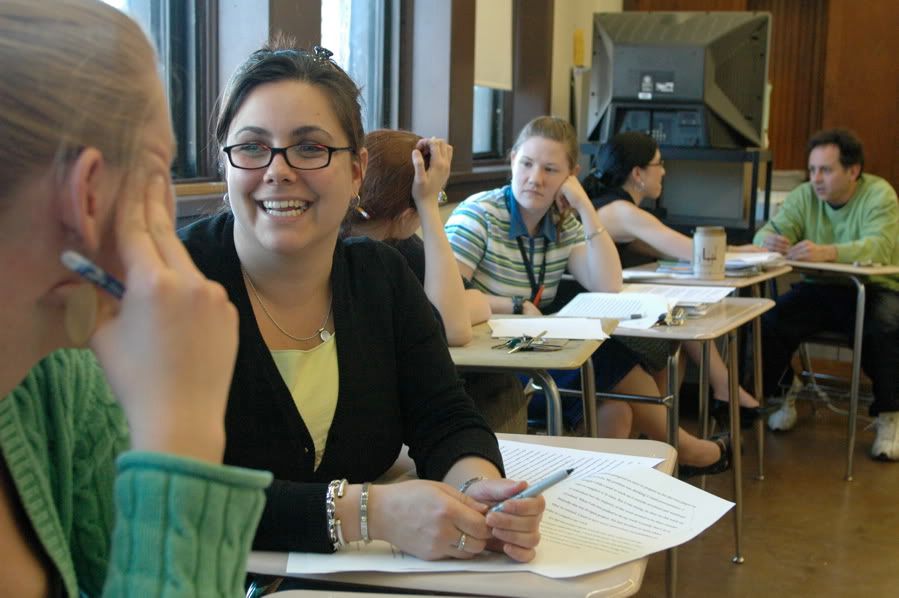I understand why school systems are moving to standardized tests, prescriptive textbooks, and top-down mandates from education leaders. I really do. It's easy and it's relatively inexpensive. If you have a new teacher in a school, it's much easier to give them a textbook, tell them the students are on chapter four and by the end of the semester they should be at chapter eight. Show them to their classroom and everything is taken care of. No need to check on them again unless you hear a complaint from a parent or from another teacher. Similarly, if you want to know how much a student is learning, take a look at last year's test scores and compare them to this year's. So easy. Yet this is not how great schools, teachers, or students are developed. If we want our students to be creative, if we want our students to think deeply, if we want our students to collaborate with each other, then we need to foster the same creative, thoughtful, and collaborative spaces for our teachers. And most importantly, we need to honor the skills of our teachers as professionals who hone their craft over many years and have the capacity, when supported, to do extraordinary work.
Yes, there are poor teachers in every school. But this is precisely why we need to build opportunities for teachers in every school to develop and share their ideas about teaching, so the majority of teachers, who are committed and thoughtful, will help the others to improve their practice. I believe we need to make schools idea incubators, where teachers have ample time to develop curriculum together, exchange best practices, and look at the work of their students consistently over time. Stanford education professor Linda Darling-Hammond writes:
The kinds of changes that society wants and schools need cannot be mandated. They can be accomplished only by investing in teachers’ knowledge and their capacity to make responsible judgments in the complex work of teaching and in the work of transforming schools.
Previously I discussed designing a common vocabulary for teaching and learning across the school. The next step is to organize the teachers in the school into pods. A pod is a group of two to six teachers who teach similar subject areas and/or age groups. This pod will stay together throughout the year and share work with each other at least on a monthly basis and preferably on a weekly basis. At our school, Habla, we only have a few teachers so it's quite easy for us to facilitate the exchange of ideas. I use the word "facilitate" because our job as education leaders is to provide a space and inspiration for teachers to have rich conversations about the work they do in classrooms.
Teachers sharing ideas and talking is not new in education. For several decades a movement called Critical Friends Groups was popular in schools. The idea was that teachers would meet on a regular basis and share ideas. When I was part of one in a public school, I loved the time speaking with colleagues, and yet I found they usually lacked a critical element: purpose. We would share and talk about student work, we would talk about our hopes and challenges about our students, but I found the conversations didn't build on one another or move beyond the room.
Therefore, when we took on the redesign of a large public school in Providence, Rhode Island, I knew the Critical Friends Group design wouldn't work. We needed as a school to move with more urgency. And yet we knew we couldn't mandate the changes in the school. We needed the creative energy of the teachers, and it was critical to support them as the school developed. Therefore we placed teachers in small groups we called pods, similar to Critical Friends Groups, yet these small groups each had concrete and clear purposes. Since there were about 150 teachers in the school, we appointed a group of teacher leaders, nine teachers who would lead about six pods each. Each week the teacher leaders met and together we developed the goals for the year and structures for facilitating the work of the pods. What is critical is we left the curricular design to the teachers. Using the common vocabulary across the school, they collaborated on developing curricula. As the year progressed we went beyond curriculum to share teaching methodologies, moving from the what of teaching to the how.

Teachers plan in pods at Hope High School. Photograph by Mary Beth Meehan
And now this school, Hope High School, like many of our schools across the United States, is in danger of losing all progress. A regressive superintendent, formally from the military, is moving all the schools across the city to the same schedule of forty-five minute periods. He'll take away the time the teachers have to plan. And he'll give teachers the same textbooks and mandated curriculums to teach across all schools at the same time. Why? Because it's easier to do this than to invest in the creative capacity of our teachers. It's cheaper to do this than to pay for the teacher's time to collaborate. We've been there before in education. We've done that. Let's put teaching back in the hands of the teachers.